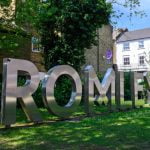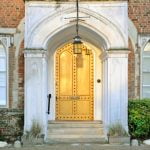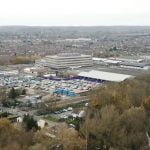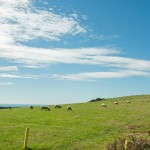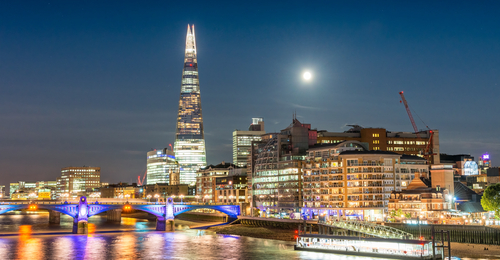
A quick guide to Southwark!
Overview
The borough of Southwark is located in south London. In 1965, the Metropolitan Boroughs of Southwark, Camberwell and Bermondsey were merged to form the London Borough of Southwark. The borough borders the River Thames to the north, Lambeth to the west, Lewisham to the east and Bromley and Croydon to the south. Southwark is known for being home to some of London’s best attractions, which includes the world-renowned venues of the Tate Modern, Shakespeare’s Globe Theatre, The Shard and the Borough Market. The Borough of Southwark has an area of just under 29 km2 and at the 2011 UK Census, the population was recorded as 288,283.
A Very Brief History
The Romans were the first to build a settlement at the location of present-day Southwark. They built a bridge over the Thames linking the borough with Londinium, guaranteeing the settlement’s future importance. When the Romans left Britain in the early 5th century, they were quickly replaced in Southwark by new settlers, the Saxons. They named the place ‘South Work’, which eventually became known as Southwark.
In 1066, Southwark was razed to the ground during the Norman invasion of England, led by William the Conqueror. However, it was rapidly rebuilt, and by 1106, it had its own priory. Southwark went on to thrive during the Middle Ages. However, from as early as the 14th century, the borough became synonymous with crime and was known as ‘’the favourite resort of thieves and vagabonds of every description.”
Southwark as a long history of immigration. The Dutch and Flemish arrived throughout the 16th and 17th century. The Germans and Irish came in the 19th century. More recently, Caribbean, South Asian and African migrants have come to call Southwark home.
In the 17th century, Bankside became the home to a number of London’s public theatres, including Shakespeare’s Globe Theatre. The fact that Southwark enjoyed a certain degree of autonomy from the more puritanical London, made it a mecca for disreputable entertainment. For many years prior to the 1600s, it had housed a notorious red-light district. Not unsurprisingly, given its salacious reputation, Southwark also became the home to a number of prisons, including the Clink, the King’s Bench and the Marshalsea.
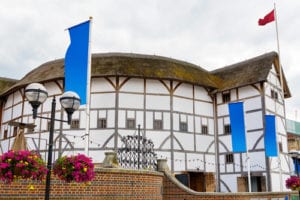
Shakespeare’s Globe Theatre – considered to be a good reconstruction of the original Elizabethan building
From the mid-17th century onwards a district of Southwark, Rotherhithe, was at the heart of shipbuilding on the Thames. The earliest known ship built there was HMS Taunton, launched in 1654 by William Castle. Although Rotherhithe’s seafaring credentials stretch back even further, as in 1620, the Pilgrim Fathers had notably set sail from there for America.
Until 1750, the only crossing over the Thames was London Bridge, which was situated at the site of the old Roman Bridge, so all traffic to and from the Southeast had to pass through Southwark. However, the rapid development of Southwark started in the late 18th century and was very much linked to the building of new bridges over the Thames. By the end of the 18th century, Bermondsey was already producing a third of the country’s leather, a notable dirty, smelly industry. At the time, Camberwell was one of the few districts with clean air and a ready supply of fresh water, which helped it develop as a middle-class suburb. Walworth, Peckham, Nunhead and East Dulwich all developed rapidly during the 19th century, following London’s unrelenting demand for housing and improvements to transport.
In 1905, Southwark parish church, St Saviour’s, became a cathedral. However, only a few fragments of the original 12th-century church survive. The church in its present form, dates back to between 1220 and 1420, making it the first Gothic church in London.
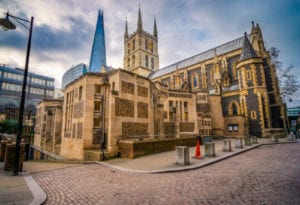
Southwark Cathedral – St Saviour’s
In 1921, Southwark Bridge was opened and replaced Queen Street Bridge, which had been constructed in 1819. About 500m downstream, the current ‘London Bridge’ crossing, opened to traffic in 1973, replacing a 19th-century stone-arched bridge.
In 1971, HMS Belfast, a light cruiser launched in 1938, which had served in WW2 and the Korean War, but decommissioned in 1963, was moored in the Thames at Southwark. It was restored by a private trust back to its former glory and became a nautical museum. In 1978, the ship became part of the Imperial War Museum and now receives over 250,000 visitors, annually.
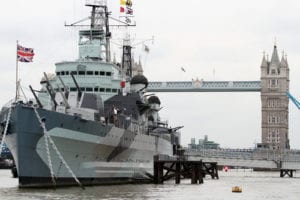
HMS Belfast with Tower Bridge in the background
Today, Southwark is still very much an ethnically diverse community of great contrast. There is prosperity in the south of Borough but deprivation can also be found, especially in parts of Peckham and Walworth. Its riverfront is very much considered to be the cultural heart of London, which has many modern buildings of international standing.
Did you know?
- Legendary British actor, Hollywood superstar and archetype Cockney, Michael Caine, was born in Southwark in 1933.
- Mr Caine is in esteemed company, as other people of worldwide fame also born in Southwark include; Charles Dickens, Isambard Kingdom Brunel, Charlie Chaplin, Enid Blyton, Boris Karloff and Michael Faraday.
- In November 1961, Britain’s first self-service petrol station opened in Southwark.
- Peckham, which provided the setting for the highly acclaimed and award-winning British TV sitcom ‘Only Fools and Horses’, is a district of Southwark.
Getting Around!
It’s generally recommended not to drive in Central London as it’s far easier to get around on the train or tube. Southwark has good links to both the National and Overground rail networks. However, Underground (Tube) stations are only found along the northern edge of the Borough on the Jubilee, Northern and Bakerloo Lines. National Rail services that run through Southwark are operated by Southern, Southeastern and Thameslink.
Railway and tube stations situated with the Borough of Southwark are:
London Underground (Tube) stations
Bermondsey (Jubilee line)
Borough (Northern line)
Canada Water (Jubilee line)
Elephant & Castle (Bakerloo and Northern line)
Kennington (Northern line)
London Bridge (Jubilee and Northern line)
Southwark (Jubilee line)
London Overground stations
Surrey Quays
Rotherhithe
Canada Water
Denmark Hill
Peckham Rye
Queens Road Peckham
Railway stations
Gipsy Hill
Denmark Hill
East Dulwich
West Dulwich
London Bridge
North Dulwich
Nunhead
Peckham Rye
Queens Road Peckham
Sydenham Hill
South Bermondsey
Elephant and Castle
Things to see and do!
Southwark is well known for being the home to some of London’s best attractions. Some of the most popular are listed below:
London Bridge – 203 Tooley Street
Tower Millenium Pier – Tower Bridge
Tower Bridge – Tower Bridge
HMS Belfast – Morgan’s Lane, Tooley Street
The London Bridge Experience & London Tombs – 2–4 Tooley Street
The Old Operating Theatre Museum & Herb Garret – 9a St Thomas
Tower of London – Tower Hill
The Medieval Banque – Ivory House, St Katharine’s Dock
The Golden Hinde – St Mary Overie Dock, Cathedral Street
Clink Prison Museum – 1 Clink Street
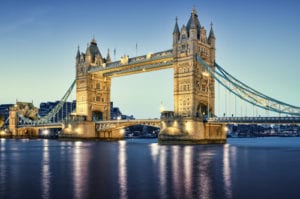
Tower Bridge – one of London’s most iconic landmarks
Where to stay?
If you’re on a budget there are some offerings of hostel style accommodation in or close to Southwark. There’s plenty of B & B/Guesthouse/Basic Hotel accommodation. If you’re looking for a bit more luxury then there’s also plenty 3, 4 and 5-star hotels in the area. An alternative would be to rent an apartment – most have no minimum let period. While the majority of apartments cater to couples, some can accommodate up to 6 people. Indicative prices for the most readily available types of accommodation/per night, based on 2 adults sharing are as follows:
Hostel: £30 – 40
B & B/Guesthouse/Basic Hotel: £60 – £90
3/4/5 Star Hotel: £200 – £400
Apartments vary greatly based on no. of available berths, location and standard
